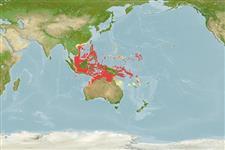Environment: milieu / climate zone / depth range / distribution range
Ecología
marino asociado a arrecife; no migratorio; rango de profundidad 5 - 147 m (Ref. 90102). Tropical; 22°N - 20°S, 104°E - 172°E
Indo-West Pacific: Philippines, Indonesia, New Guinea, northeastern Australia (Cape York to northern Great Barrier Reef) Belau, Truk, Caroline Islands, Marshall Islands, and the Solomon Islands. Reported from Malaysia (Ref. 5756).
Length at first maturity / Tamaño / Peso / Age
Maturity: Lm ?, range 42 - ? cm
Max length : 75.0 cm TL macho / no sexado; (Ref. 5222); peso máximo publicado: 1.2 kg (Ref. 40637)
Espinas dorsales (total) : 7 - 8; Radios blandos dorsales (total) : 10 - 12; Espinas anales: 3; Radios blandos anales: 8.
Inhabits drop-offs and steep channel slopes (Ref. 9710). Very little has been published on its biology. Reported to forage in groups of two or three for rock- and sand living crustaceans and fishes. Rare in most areas (Ref. 9710). In the Hong Kong live fish markets (Ref. 27253).
Life cycle and mating behavior
Maturities | Reproducción | Spawnings | Egg(s) | Fecundities | Larva
Heemstra, P.C. and J.E. Randall, 1993. FAO Species Catalogue. Vol. 16. Groupers of the world (family Serranidae, subfamily Epinephelinae). An annotated and illustrated catalogue of the grouper, rockcod, hind, coral grouper and lyretail species known to date. Rome: FAO. FAO Fish. Synop. 125(16):382 p. (Ref. 5222)
IUCN Red List Status (Ref. 130435)
Threat to humans
Reports of ciguatera poisoning (Ref. 5222)
Human uses
Pesquerías: escaso valor comercial
Herramientas
Special reports
Download XML
Fuentes de Internet
Estimates based on models
Preferred temperature (Ref.
123201): 26.6 - 29.3, mean 28.7 °C (based on 1890 cells).
Phylogenetic diversity index (Ref.
82804): PD
50 = 0.5078 [Uniqueness, from 0.5 = low to 2.0 = high].
Bayesian length-weight: a=0.01023 (0.00643 - 0.01629), b=3.03 (2.90 - 3.16), in cm total length, based on LWR estimates for this species & (Sub)family-body (Ref.
93245).
Nivel trófico (Ref.
69278): 4.0 ±0.66 se; based on food items.
Resiliencia (Ref.
120179): Bajo, población duplicada en un tiempo mínimo de 4.5-14 años (Preliminary K or Fecundity.).
Fishing Vulnerability (Ref.
59153): Moderate to high vulnerability (50 of 100).
Nutrients (Ref.
124155): Calcium = 33.3 [19.4, 63.3] mg/100g; Iron = 0.563 [0.294, 0.941] mg/100g; Protein = 19 [17, 21] %; Omega3 = 0.162 [0.105, 0.257] g/100g; Selenium = 53.9 [31.7, 98.6] μg/100g; VitaminA = 42.2 [14.7, 134.2] μg/100g; Zinc = 0.813 [0.559, 1.195] mg/100g (wet weight);
